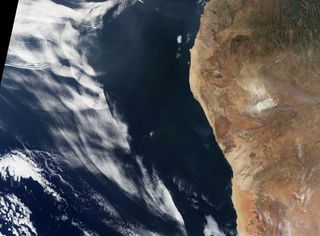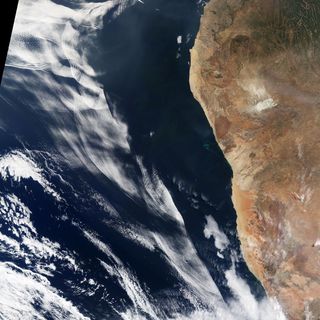Gorgeous Gravity Waves Intersect Near Africa (Photo)

Interlacing waves of clouds decorate the sky above the coast of Angola in a new satellite image.
The image, taken June 26 by an instrument on NASA's Terra satellite, highlights the atmospheric patterns off the coast of West Africa. The clouds are called gravity waves, which form as gravity and buoyancy try to balance each other out. (Gravity waves are different than gravitational waves, which are ripples in space-time.)
According to NASA's Earth Observatory, the culprit here is dry, cool air moving out of the nighttime Namib desert and over the ocean. This cool air pushes the humid and warm ocean air up (there's the buoyancy part of the equation). As the moisture rises and condenses to form clouds, gravity pushes it back down, where it hits the rising column of dry air and gets hoisted up again. (A similar push-and-pull occurs at the ocean's surface because of the interactions of wind and gravity.)
[See Photos of the Namib Desert's Fairy Circles]

The ripple-like clouds seen in this image represent the peaks of the gravity waves, where the moisture in the air condenses. The clear skies between the peaks are the troughs of the gravity waves.
On the day the Moderate Resolution Imaging Spectroradiometer on the Terra satellite captured this image, winds were creating gravity waves in all different directions, Bastiaan van Diedenhoven, who researches ice-containing clouds at NASA's Goddard Space Flight Center, told the Earth Observatory. The result was a complicated pattern of crisscrossing clouds curving across at least 620 miles (1,000 kilometers). These patterns are often seen off Angola and Namibia in the morning and early afternoon, van Diedenhoven told the Earth Observatory, and tend to be pushed out to sea as the day goes on.
Gravity waves may be important for commercial air travel. A study presented in 2012 at the annual meeting of the American Geophysical Union found that gravity waves can break against an aircraft just as ocean waves break against a beach, causing turbulence in otherwise clear skies.
Sign up for the Live Science daily newsletter now
Get the world’s most fascinating discoveries delivered straight to your inbox.
Original article on Live Science.

Stephanie Pappas is a contributing writer for Live Science, covering topics ranging from geoscience to archaeology to the human brain and behavior. She was previously a senior writer for Live Science but is now a freelancer based in Denver, Colorado, and regularly contributes to Scientific American and The Monitor, the monthly magazine of the American Psychological Association. Stephanie received a bachelor's degree in psychology from the University of South Carolina and a graduate certificate in science communication from the University of California, Santa Cruz.
